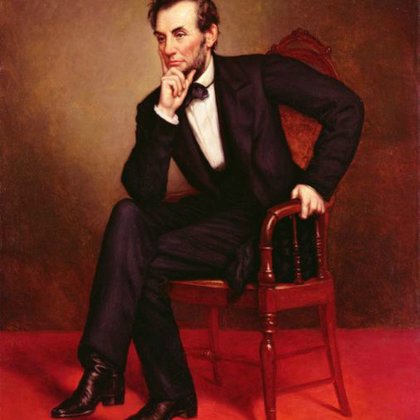ABRAHAM LINCOLN (1809-1865) WAS THE 16TH PRESIDENT OF THE USA.SOMEONE SHOT AT LINCOLN IN 1864,LINCOLN AS THE FIRST PRESIDENT TO BE ASSASSINATED. HE BROUGHT ABOUT THE EMANCIPATION OF SLAVE.
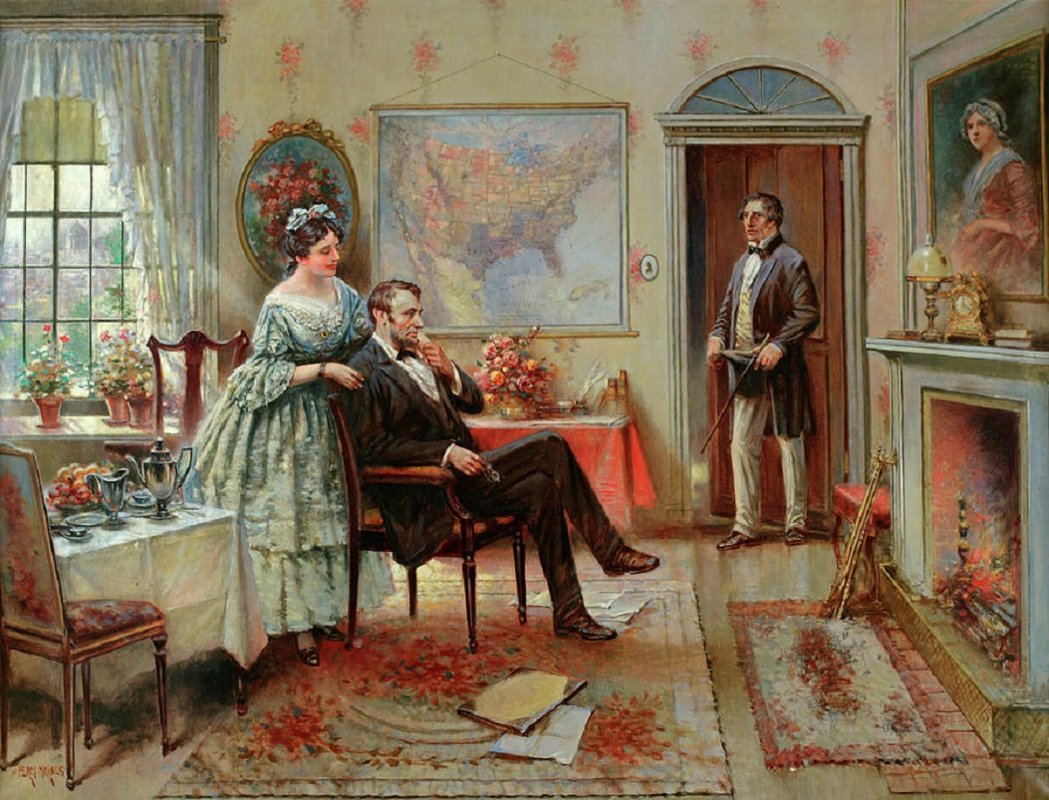 Abe and his wife Mary Lincoln,called “Mother” by Mr. Lincoln, Mary Todd was the fourth child of Robert
and Eliza Parker Todd. Raised in Lexington, Kentucky, Mary came to
Springfield, Illinois to visit her sisters in 1840. After a tumultuous
courtship, she married Abraham Lincoln on November 4, 1842. Often
self-absorbed and petulant, she was nonetheless devoted to her immediate
family while frequently engaged in feuds with other family members. As a
young woman, Mary was as buoyant and debonair as she was bitter and
dour as a widow. Raised in a slave-owning family, she became a fervent
abolitionist, one of whose closest friends was her black seamstress,
Elizabeth Keckley.
Abe and his wife Mary Lincoln,called “Mother” by Mr. Lincoln, Mary Todd was the fourth child of Robert
and Eliza Parker Todd. Raised in Lexington, Kentucky, Mary came to
Springfield, Illinois to visit her sisters in 1840. After a tumultuous
courtship, she married Abraham Lincoln on November 4, 1842. Often
self-absorbed and petulant, she was nonetheless devoted to her immediate
family while frequently engaged in feuds with other family members. As a
young woman, Mary was as buoyant and debonair as she was bitter and
dour as a widow. Raised in a slave-owning family, she became a fervent
abolitionist, one of whose closest friends was her black seamstress,
Elizabeth Keckley.
Abraham Lincoln (February 12, 1809 – April 15, 1865) served as the 16th President of the United States from March 1861 until his assassination in April 1865. Lincoln died the morning after being shot at Ford's Theatre in Washington, D.C Married: Mary Todd Lincoln Children: Robert, Edward, William, Thomas Nickname: Honest Abe. In Abraham’s youth the family moved frequently, trying to stay one step ahead of financial trouble and illness, before eventually settling down in Coles County, Illinois. Along the way, Lincoln became known for his physical strength as well as his formidable self-education. At the age of 21, he left home and canoed to New Salem, Illinois, where he signed on to a local riverboat firm. After a short stint on the western rivers, a shorter stint as manager of a general store, and service as a militia captain during the Black Hawk Wars, he made his first run for a seat on the Illinois General Assembly, which he lost. In 1834, he won his second General Assembly election and served four terms as a member of the Whig Party while taking up the practice of law in Springfield.In 1842, Lincoln was got married to a 23-year old woman named Mary Todd who was just 5 feet 2 inches while Lincoln was 6 feet 4 inches. They had four boys, only one of whom lived to maturity. Mary Todd Lincoln, the First Lady of the United States of America, passed away in 1882.Lincoln's first love was Ann Rutledge. He met her when he first moved to New Salem, and by 1835 they had reached a romantic understanding, if not a formal engagement. Ann is quoted as desirous of advising a former love before "consummating the engagement with Mr. L." Rutledge, however, died on August 25, probably of typhoid fever.In the early 1830s, he met Mary Owens from Kentucky when she was visiting her sister. Late in 1836, Lincoln agreed to a match with Mary proposed by her sister, if Mary ever returned to New Salem. Mary did return in November 1836 and Lincoln courted her for a time; however they both had second thoughts about their relationship. On August 16, 1837, Lincoln wrote Mary a letter from his law practice in Springfield, suggesting he would not blame her if she ended the relationship. She never replied, and the courtship was over.In 1840, Lincoln became engaged to Mary Todd, from a wealthy slaveholding family in Lexington, Kentucky. They met in Springfield in December 1839, and were engaged sometime around that Christmas.A wedding was set for January 1, 1841, but the couple split as the wedding approached. They later met at a party, and then married on November 4, 1842, in the Springfield mansion of Mary's married sister. In 1844 the couple bought a house in Springfield near Lincoln's law office.Lincoln, a tall, angular man, quickly strides out. Lincoln was a self-educated man. He had little formal education, however, he practiced law. On the other hand, Lincoln’s dad was only literate enough to write his name.As an outspoken opponent of the expansion of slavery.Nominee for president - 1860 May 18, 1860 - Abraham Lincoln is nominated to be the Republican candidate for President of the United States. He opposes Northern Democrat, Stephen A. Douglas, and Southern Democrat, John C. Breckinridge. In June, he writes a longer autobiography. The first portrait by Mathew Brady - February, 1860 November 6, 1860 - Abraham Lincoln is elected as 16th President of the United States, and is the first Republican. He receives 180 of 303 possible electoral votes and 40 percent of the popular vote. December 20, 1860 - South Carolina secedes from the Union – followed within two months by Mississippi, Florida, Alabama, Georgia, Louisiana and Texas. February 11, 1861 - President-elect Lincoln gives a brief farewell to friends and supporters at Springfield and leaves by train for Washington, D.C. During the train trip, he is warned about a possible assassination attempt. President-elect Lincoln - February 23, 1861 March 4, 1861 - Inauguration ceremonies are held in Washington, D.C. President Lincoln delivers his First Inaugural Address. April 12, 1861 - At 4:30 a.m., Confederate artillery opens fire on Fort Sumter in Charleston Harbor.He won the Republican Party nomination in 1860 and was elected president later that year. During his term, he helped preserve the United States by leading the defeat of the secessionist Confederate States of America in the American Civil War. He introduced measures that resulted in the abolition of slavery, issuing his Emancipation Proclamation in 1863 and promoting the passage of the Thirteenth Amendment to the Constitution in 1865.In 1860, Lincoln ran for President of the United States. He was a member of the fairly new Republican party which strongly opposed allowing any of the southern states to secede .They said they would allow for slavery to continue in the southern states, but that it would not be allowed to spread to new U.S. states or territories. Lincoln is most famous for leading the country during the American Civil War. His leadership in the North helped the country to remain strong and defeat the South keeping the country united. He also pushed for the freedom of all slaves throughout the nation.Lincoln's leadership qualities were evident in his close supervision of the victorious war effort, especially in his selection of Ulysses S. Grant and other top generals. Historians conclude that he handled the factions of the Republican Party brilliantly by bringing its leaders into his cabinet and forcing them to cooperate. In crisis management, he defused a war scare with the United Kingdom (1861), he outmaneuvered the Confederacy and took control of the border slave states in 1861 – 1862, and he managed his own landslide reelection in the 1864 presidential election.
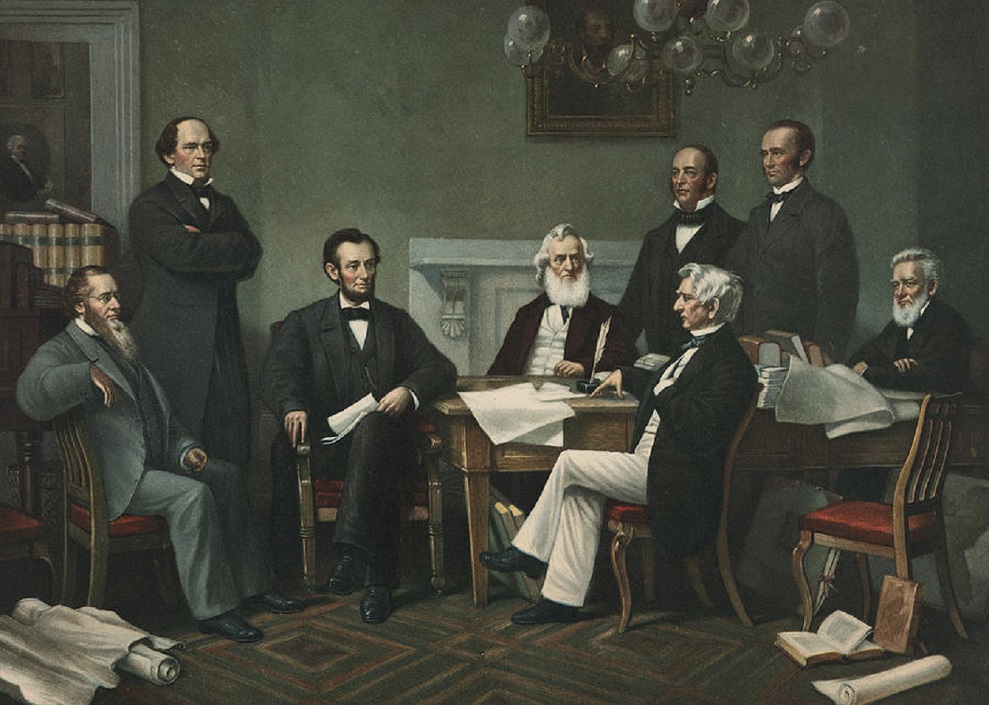 Abraham Lincoln and his Cabinet,President Lincoln’s cabinet included all of his major rivals for the Republican nomination for President in 1860—William H. Seward, Salmon P. Chase, Simon Cameron and Edward Bates. Some of these men had been effectively promised positions as part of the negotiations that led to Mr. Lincoln’s nomination at the Republican national convention in May 1860. Many of them objected to the inclusion of each other in the cabinet.
Abraham Lincoln and his Cabinet,President Lincoln’s cabinet included all of his major rivals for the Republican nomination for President in 1860—William H. Seward, Salmon P. Chase, Simon Cameron and Edward Bates. Some of these men had been effectively promised positions as part of the negotiations that led to Mr. Lincoln’s nomination at the Republican national convention in May 1860. Many of them objected to the inclusion of each other in the cabinet.
Abraham Lincoln was Commander-in-chief of the armed forces of the United States.In times of war or national emergency to manage the national economy and protect the security of the United States.The Civil War was much more costly than many people anticipated and at times Lincoln appeared to be losing the support of the general population. But, Lincoln’s patient leadership, and willingness to work with unionist Democrats held the country together. Lincoln oversaw many of the military aspects of the war and promoted the general Ulysses S Grant to command the northern forces. Initially, the war was primarily about the secession of southern states and the survival of the Union, but as the war progressed, Lincoln increasingly made the issue of ending slavery paramount.After a difficult opening two years, by 1863, the tide of war started to swing towards the Union forces helped by the victory at the Battle of Gettysburg in July 1863. At the Battle of Fort Stevens in 1864 Lincoln actually came under Confederate fire, making him the second and last sitting president to be in such a position, the first being James Madison at the Battle of Bladensburg in 1814.This episode was not an exception to Lincoln's involved role in the war. As commander-in-chief, Lincoln exercised the highest authority over the American military. Applying his old talent for self-education, Lincoln began to voraciously study the principles that composed contemporary military thought. He made the decision to resupply Fort Sumter,which prompted the Confederate barrage igniting the Civil War, and continued to take an active hand in formulating the grand strategy of the war. Lincoln appointed every top general in the Union army, including Ulysses S. Grant. Aides would often find him in the telegraph office poring over dispatches from the field some days he would visit the office four or more times. In addition to making frequent appearances in camps and at parades, Lincoln even personally tested such new pieces of military technology as the “coffee-mill” machine gun and the Spencer repeating rifle.In the early days of the war, a significant portion of Marylanders attempted to thwart the North's military mobilization. Groups of citizens disrupted rail lines, rioted, and grumbled about leaving the Union. In response, Lincoln suspended writ of habeas corpus in the state on April 27, 1861, allowing his agents to imprison anyone, including the Mayor of Baltimore, for any length of time without trial or probable cause. The courts ruled that the president had overstepped his constitutional bounds; Lincoln ignored them. This limitation on civil liberties gradually spread across the Union until some 13,000 citizens were jailed. In 1863, Congress passed a bill permitting the executive suspension of the writ. Many newspapers were also shut down, taken over, or intimidated throughout the conflict. However, Lincoln's presidency was not entirely defined by running the Civil War. He appointed abolitionists to the Supreme Court, instituted the nation’s first income tax, implemented two international tariffs, and created the Department of Agriculture. He also proclaimed a national day of Thanksgiving, which had previously been only irregularly declared, as an institutional tradition for the first time on the final Thursday of November, 1863.In the aftermath of the civil war, Lincoln sought to reunite the country – offering a generous settlement to the south. When asked how to deal with the southern states, Lincoln replied. “Let ’em up easy.” Lincoln was opposed by more radical factions who wanted greater activism in the south to ensure civil rights for freed slaves.On January 31, 1865, Lincoln helped pass through Congress a bill to outlaw slavery. The Thirteenth Amendment to the United States Constitution was officially signed into law on December 6, 1865. Some northern abolitionists and Republicans wanted Lincoln to go further and implement full racial equality on issues of education and voting rights. Lincoln was unwilling to do this (it was a minority political view for the time) Frederick Douglass, a leading black activist (who had escaped from slavery) didn’t always agree with the policies of Lincoln but after meeting Lincoln, he said enthusiastically of the Preside.After a long war there were many who felt that Southerners should be severely punished for their insurrection. Some wanted to hold rebels criminally accountable, exact huge financial penalties, and relegate the Southern states to second-class status. Lincoln, on the other hand, advocated amnesty and a swift return to an equal union. The effects of Lincoln’s plan will only ever be speculative. His assassination ensured that the ultimately injurious process of Reconstruction would leave deep fissures in American society. Lincoln looked even more worn out than usual, in March General Grant invited Lincoln to City Point near Petersburg. Lincoln immediately accepted. He was not alone; Mary insisted on joining him, so a party including Tad Lincoln, a maid, a bodyguard, and a military aide boarded the River Queen on March 23 for the trip. Son Robert, now an adjunct to Grant’s army, met them on their arrival the next evening. Lincoln took time to visit the troops and confer with Generals Grant and Sherman and Admiral David Porter. Overall it was a restful but productive visit. That changed when Mary Lincoln flew into a jealous rage at seeing General Ord’s wife riding “too close” to her husband, after which Lincoln sent Mary back to Washington. Soon after her departure, however, the Union captured Richmond, which the Confederate leadership had abandoned. She insisted on returning, this time bringing a large entourage that included her ex-slave dressmaker, Elizabeth Keckley, who had been born in nearby Petersburg.During Mary’s absence, Lincoln took Tad into Richmond. After landing at the docks, Lincoln and Tad walked the mile or so to the Confederate White House that had served until a few days earlier as Jefferson Davis’s office. Surrounding him along the way were hundreds of ex-slaves who wanted to see the “Great Emancipator,” while anxious white southerners stared suspiciously from their windows.On April 8, Lincoln visited the Depot Field Hospital at City Point. Over the course of a full day he shook the hands of more than 6,000 patients, including a few sick and wounded Confederate soldiers. Feeling the pressure of business, Lincoln left City Point to return to Washington that evening. The next day, Lee surrendered his army to General Ulysses S. Grant, effectively ending the war.
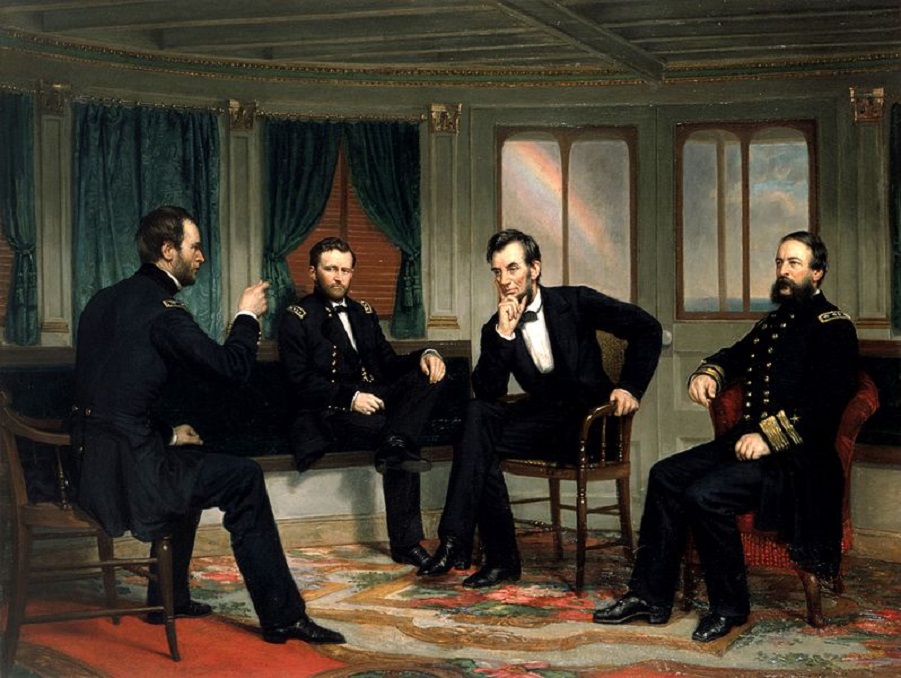 "The
Peacemakers". Seated aboard the Union steamer River Queen are Maj. Gen.
William T. Sherman, Lt. Gen. Ulysses S. Grant, President Abraham
Lincoln, and Rear Adm. David D. Porter. The four men met to discuss
peace terms to follow the war. It
depicts the historic March 28, 1865, strategy session by the Union high
command on the steamer River Queen during the final days of the
American Civil War.
"The
Peacemakers". Seated aboard the Union steamer River Queen are Maj. Gen.
William T. Sherman, Lt. Gen. Ulysses S. Grant, President Abraham
Lincoln, and Rear Adm. David D. Porter. The four men met to discuss
peace terms to follow the war. It
depicts the historic March 28, 1865, strategy session by the Union high
command on the steamer River Queen during the final days of the
American Civil War.In the autumn of 1862, following the Battle of Antietam, he announced his Emancipation Proclamation. The American Civil War is the defining event in the history of the United States. After fighting from April 1861 until April 1865, the Southern Confederate States lay down their arms to the Northern United States. More than 600,000 people are killed. Based on the current population, that number today is equivalent to six million deaths.The Battle of Gettysburg occurs in the middle of the war, on July 1st, 2nd and 3rd, 1863. When the Civil War ends a year and a half later, slavery is abolished—and in the decades that follow, the United States becomes the most powerful nation on earth. Before the war, it was said, “the United States are” After the war, it becomes “the United States is.”At the center of this conflict is President Abraham Lincoln. His election to the presidency in 1860, on an anti-slavery platform, leads to the secession of 11 Southern states and the founding of a new nationthe Confederate States of America.The war begins in April 1861 when the Confederates fire on Fort Sumter in Charleston Harbor, South Carolina. Both sides expect the war to end quickly. Lincoln believes the 75,000 men he calls to serve for three months will be sufficient to put down the rebellion. He is wrong. Two years later, in the summer of 1863, there will be 51,000 casualties here at Gettysburg alone.While the war is fought throughout the country, what happens in the East gets the most press and effects the popular sentiment. In the East Confederates are winning the war – battle after battle after battle. The largest of the Union armies the Army of the Potomac – is consistently beaten by the most important Confederate army – the Army of Northern Virginia. These two armies will meet at Gettysburg.The Battle of Gettysburg, Pennsylvania (July 1–July 3, 1863), was the largest battle of the American Civil War as well as the largest battle ever fought in North America, involving around 85,000 men in the Union’s Army of the Potomac under Major General George Gordon Meade and approximately 75,000 in the Confederacy’s Army of Northern Virginia, commanded by General Robert Edward Lee. Casualties at Gettysburg totaled 23,049 for the Union (3,155 dead, 14,529 wounded, 5,365 missing). Confederate casualties were 28,063 (3,903 dead, 18,735 injured, and 5,425 missing), more than a third of Lee’s army.As a young man Abraham Lincoln first gains national attention by opposing war. Now he is a war president. Lincoln struggles for two years to find a capable General to lead his army. His Commanders prove too old, overcautious, overconfident, or incompetent. By June 1863 the Union army has fought five battles and has not won a major victory. Each time the commanding general is fired. Generals fear Abraham Lincoln. He is a representative of a budding capitalistic culture based on hard competition. Those who win advance. Lose and you're out. In Lincoln’s system good people are lost along the way, but by the end, he ends up with the finest Union generals. And they win the war – in 1865. It granted freedom to slaves but only to those in the areas still in rebellion, which didn’t recognize his authority. It was a war measure, meant to prevent European recognition of the slaveholding Confederacy, and it shifted the war from one to preserve the Union to one that would both preserve the Union and end slavery.Other controversial war measures taken by Lincoln and his administration included infringing on some Constitutional rights, including suspending habeas corpus and shutting down newspapers that opposed the war. He signed the bill admitting West Virginia as a state of the Union, although it had been formed from Virginia without the permission of the state’s government at Richmond, which many, including half of his cabinet members, believed was a violation of Article IV, Section 3 of the Constitution. Nevada was admitted at least in part to provide another pro-Union state. In presidential elections of 1864, Lincoln believed he would not be reelected. The war had dragged on for over three years, draining the treasury. Major battles, like the Battle of Shiloh, the Battle of Antietam, the Battle of Fredericksburg, the Battle of Chancellorsville, the Battle Gettysburg, and the Battle of Chickamauga, had each produced over 10,000 casualties, far beyond anything the nation had experienced in previous wars. Grant’s current campaign in Virginia had already suffered nearly 50,000 losses. Radical abolitionists in the North were upset with him for not pressing harder on the slavery issue.The Democratic Party, banking on war weariness, was running George McClellan, the former general, as their candidate, under the slogan, “The Union as it was, and the Constitution as it is,” and pledging a truce with the Confederacy. Indeed, Lincoln might have lost his bid for re-election, and with it the war, had Maj. Gen. William T. Sherman not captured Atlanta in early September, giving the Union a major victory. Other contributing factors included Lincoln allowing soldiers in the armies to vote in their camps, something that had never been done before. The Democrats themselves made several missteps that hurt their chances. Lincoln won reelection and in his second inaugural address called for, “malice toward none, with charity for all,” attempting to set the stage for a reconciliation with the South.He had personally experienced the “divided house” he’d once warned of. All but one of his wife’s half-siblings fought for the Confederacy or married men who did, and one of her full brothers became a Confederate surgeon. Only three of her sisters in Illinois and their husbands remained firmly with the Union.With the light of victory clearly breaking over the horizon, Lincoln and Mary went to Ford’s Theater on the night of April 14 to see the comedy, Our American Cousin. During the performance, an actor and staunch Confederate sympathizer named John Wilkes Booth slipped into the presidential box and shot Lincoln in the head. The president died the following morning. Within 24 hours, not a shred of black crepe was to be had in the nation’s capitol as homes, stores and government buildings were draped in mourning. Even some Southern newspapers condemned the assassinationPresident Abraham Lincoln was died due to Assassination on 15th April 1865. The assassination was part of a larger conspiracy intended by Booth to revive the Confederate cause by eliminating the three most important officials of the United States government.Conspirators Lewis Powell and David Herold were assigned to kill Secretary of State William H. Seward, and George Atzerodt was tasked with killing Vice President Andrew Johnson.John Wilkes Booth, a popular 26-year-old actor who was also a Confederate sympathizer and white supremacist, had been plotting for months to abduct Lincoln and give the Confederacy another chance. But three days earlier, hearing the president talk of his plans to bring the nation together in particular, Lincoln’s plans to grant some African-American men the right to vote.Booth’s plans turned murderous.With the Confederacy on its last legs, Grant invited Lincoln to visit his headquarters in City Point (now Hopewell), Virginia, situated along the James River just a few miles from the front. “I would like very much to see you,” the general wrote, “and I think the rest would do you good.” Lincoln immediately accepted the offer, arriving on March 24, 1865, with his wife, Mary Todd, and young son Tad. In addition to seeing his older son Robert, who served on Grant’s staff, Lincoln spent time in the hospital with wounded soldiers, both Union and Confederate. He also witnessed the Battle of Fort Stedman, in which Southern troops launched a desperate and ultimately failed bid to break the long-running siege of Petersburg, Virginia, a major supply hub. Coming across dead and wounded men, the president was overheard remarking that “he had seen enough of the horrors of war” and “that he hoped this was the beginning of the end.”At the same time, Sherman was coincidentally planning his own trip to City Point. Fresh off his “March to the Sea” from Atlanta to Savannah, he had continued his slash-and-burn tactics up through the Carolinas and now appeared on the verge of linking up with Grant. Desiring a parley with his boss, Sherman wrote to Grant that he might visit “for a day or two, before diving into the bowels of the country again,” and that “in one more move” they could “checkmate” Confederate General Robert E. Lee. He then traveled nearly 100 miles to the North Carolina coast, where he hopped on a captured Confederate blockade runner that whisked him up to City Point by the afternoon of March 27. His old friend Grant was there to welcome him, and after trading stories for an hour or so, the duo called on Lincoln aboard his steamship, the River Queen. Porter, another of Sherman and Grant’s friends who commanded the Union fleet on the James River, also may have been present (he later said he attended both days’ meetings, whereas Sherman said he only attended the second).Either way, Sherman would call this first encounter a “good, long, social visit,” in which Lincoln asked questions about his “great march” and about how the troops would hold up in his absence. “When at rest or listening, his legs and arms seemed to hang almost lifeless, and his face was care-worn and haggard,” Sherman wrote of the president, “but the moment he began to talk, his face lightened up, his tall form, as it were, unfolded, and he was the very impersonation of good-humor and fellowship.” Saving more serious discussions for the following day, the two generals took their leave of Lincoln before dinner. They then spent the rest of the evening cracking jokes with other high-ranking military officials and with Grant’s wife, Julia, who gently chided them for forgetting to greet Mrs. Lincoln. Debates over strategy also took place, such as whether a cavalry unit should remain in Virginia or join Sherman in North Carolina.After meeting with additional high-ranking military officials the next morning, Sherman, Grant and Porter once again boarded the River Queen for what one Union officer described as an “informal interchange of views between the four men who held the destiny of the nation in their hands.” This time around, Grant briefed the president on his latest military maneuvers and expressed his desire to prevent Lee from uniting with a separate Confederate army in North Carolina. According to Sherman and Porter (the only two of the four to leave a written account of the conference), the generals expected at least one more major battle, much to the consternation of Lincoln, who reiterated that there had been “blood enough shed.” Sherman next turned the conversation to Reconstruction of the South, with Lincoln responding that rebel soldiers would be allowed to return to their homes as soon as they laid down their arms. He even implied that he wouldn’t punish Jefferson Davis, provided the Confederate president left the country.That very afternoon, Sherman departed for North Carolina, but not before the president purportedly told him and Grant that he liked them because they “never found fault with me.” Sherman responded in kind, writing, “Of all the men I have met, Lincoln seemed to possess more of the elements of greatness, combined with goodness, than any other.” Within days of their historic get-together, Grant finally finished cutting the roads and rail lines into Petersburg, prompting the Confederates to abandon both it and Richmond, their capital. Lincoln visited Petersburg on April 3 and Richmond on April 4, despite a warning from his secretary of war that snipers might be about. Newly freed blacks apparently thronged around him in the streets. The president then returned to Washington, D.C., on April 9, the same day as Lee’s surrender at Appomattox Court House.
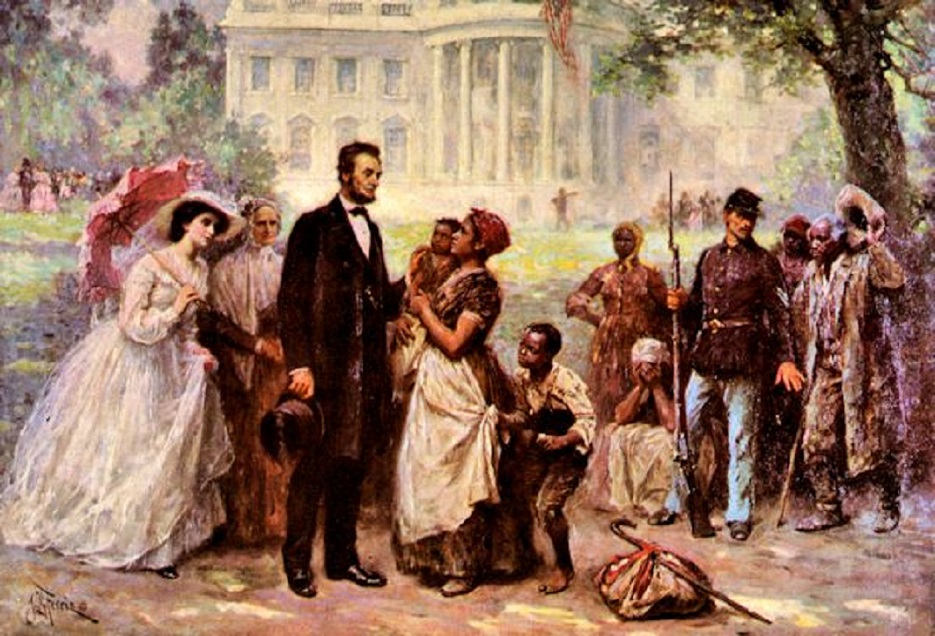 At
the time of Lincoln’s arrival in 1837, Springfield had an African
American population of approximately twenty-six – 1.78 percent of the
total population of 1,5000. Six of those twenty-six were slaves. By the
time of Lincoln’s departure in 1861, the African American population had
grown to 234 – approximately 2.5 percent of the total population of
approximately .
At
the time of Lincoln’s arrival in 1837, Springfield had an African
American population of approximately twenty-six – 1.78 percent of the
total population of 1,5000. Six of those twenty-six were slaves. By the
time of Lincoln’s departure in 1861, the African American population had
grown to 234 – approximately 2.5 percent of the total population of
approximately .
Lincoln
disapproved of slavery, but felt that preserving the Union came first.
He also felt that he had no authority as President to ban slavery from
existing states, though he could exclude it from the Territories, areas
run directly by the Federal Government.Lincoln
often said that he had believed slavery was wrong for as long as he
could remember. In a speech in Chicago on July 10, 1858 Lincoln said he
of slavery: “I have always hated it, but I have always been quiet about
it until this new era of the introduction of the Nebraska Bill
began.Lincoln’s views on slavery, however, were at odds with the
predominant racist feelings of Illinois residents. Early Lincoln
chronicler Francis Fisher Browne noted: “During the years of Lincoln’s
service in the Legislature of Illinois, the Democratic party was
strongly dominant throughout the State. The feeling on the subject of
slavery was decidedly in sympathy with the South. A large percentage of
the settlers in the southern and middle portions of Illinois were from
the States in which slave labor was sustained, and although the
determination not to permit the institution to obtain a foothold in the
new commonwealth was general, the people were opposed to any action
which should affect its condition where it was already established.
During the session of 1836-’37, resolutions of an extreme pro-slavery
character were carried through the Legislature by the Democratic party.
The aim of the measure was to prevent the Abolitionists from obtaining a
foothold in the State.Lincoln and a Whig colleague from Sangamon County
introduced a petition in the legislature condemning slavery. Lincoln
legal scholar Paul Finkelman wrote: “This early foray into the
constitutional issues of slavery suggests that Lincoln, even as a young
man, understood the constitutional limitations as well as the
constitutional possibilities of fighting slavery. He also understood the
reality of his isolation on the slavery issue. Lincoln scholar Saul
Sigelschiffer observed: “There were few sections of Illinois where
prejudice against the Negro was stronger than in Sangamon County, which
had been settled chiefly by Kentuckians.As
a young man, Mr. Lincoln had witnessed the slave system when he twice
traveled down the Mississippi River on a raft to New Orleans. Later,
Lincoln witnessed slavery in Kentucky when he visited friends and family
in the state of his birth. Lincoln also understood firsthand the impact
of racism on local life and politics in Springfield. Historian Kenneth
J. Winkle noted: “In 1850…more than twenty African Americans lived
within three blocks of the Lincoln family. One of Lincoln’s closest
black contemporaries was barber William de Fleurville, a sometime
neighbor and legal client. Lincoln scholar Richard E. Hart wrote:
“African Americans were a significant part of Lincoln’s Springfield
community. These Springfield African Americans had an impact on Lincoln
that was far greater than their numbers imply.” Hart noted that “as an
adjunct to slavery, a system of voluntary or indentured servitude
flourished in Springfield both prior to and after Lincoln’s arrival. The
system was legally permitted by the ‘Black Laws’ that were adopted by
Illinois’ first legislature in 1819 and existed until February 7,
1865.According to historian Gossie Harold Hudson, “although the majority
of people in Sangamon County expressed opposition to the evils of
slavery, Blacks in Springfield were systematically treated as inferiors,
and in many cases were held in virtual slavery. Also…the Sangamon
Journal published advertisements of alleged runaway slaves, including
detailed descriptions, rewards, warnings against employing the Negroes
so identified, and threats of penalties for aiding them. In that
environment, it is quite apparent that the Lincoln connecti must have
been as valuable to the black barber as it was unique.Slavery
issues were part of Lincoln’s legal practice.1830’s Lincoln, a young
and poor lawyer, undertook at his own expense, together with Lyman
Trumbull and Gustave Koerner, to destroy the legal basis of the Negro
indenture system which amounted to de facto slavery in Illinois. In
1839, in the case of Cromwell vs Baily, he won a decision in the
Illinois Supreme Court on behalf of an indentured Negro slave girl,
Nancy. The court ruled, in an historic decision, that in Illinois the
presumption was that a Negro was free and not subject to sale. In those
early days of Illinois, it took great courage for a young lawyer and
budding politician to fight for Negro freedom Lincoln contemporary John
Bunn alleged the “reason Lincoln appeared in so few suits in behalf of
negroes was because he didn’t want to be a party to a violation of the
Fugitive Slave law.” Mr. Lincoln argued “the way was to repeal the law.
In more than one case he suggested and advised that a few dollars be
paid to buy off those who were holding the Negro. Not all of Lincoln’s
legal work, however, favored free slaves. The Matson case was a
conspicuous example of Lincoln’s work for an Illinois slaveholder.In
the fall of 1847, Lincoln went to Washington to serve a single term in
Congress. He embraced few issues, but one was ending slavery in the
nation’s capital. Historian Richard J. Carwardine wrote: “The elements
of Lincoln’s antislavery posture were essentially in place before he
left for Washington in 1847: moral repugnance at the institution,
sympathy for the slave, respect for the protection the federal
constitution afford slavery, commitment to preserving social order,
belief in the essential goodwill of the southern slaveholder, and the
need for common, gradual action by North and South on a problem for
which they shared responsibility.In Washington Lincoln found that the
slavery issue was heating up. The creation of the Free Soil party in
August 1848 and its participation in the presidential campaign reflected
the importance of the anti-extension sentiment in the country. The
party’s emphasis was as much to protect economic opportunity for free
whites as it was to prevent slavery’s spread.As
for Lincoln's general motivations, his 1862 letter to Horace Greeley,
written at a time when the Emancipation Proclamation had already been
drafted, but not yet issued, gives some insight:
I
would save the Union. I would save it the shortest way under the
Constitution. The sooner the national authority can be restored; the
nearer the Union will be "the Union as it was." If there be those who
would not save the Union, unless they could at the same time save
slavery, I do not agree with them. If there be those who would not save
the Union unless they could at the same time destroy slavery, I do not
agree with them. My paramount object in this struggle is to save the
Union, and is not either to save or to destroy slavery. If I could save
the Union without freeing any slave I would do it, and if I could save
it by freeing all the slaves I would do it; and if I could save it by
freeing some and leaving others alone I would also do that. What I do
about slavery, and the colored race, I do because I believe it helps to
save the Union; and what I forbear, I forbear because I do not believe
it would help to save the Union. I shall do less whenever I shall
believe what I am doing hurts the cause, and I shall do more whenever I
shall believe doing more will help the cause. I shall try to correct
errors when shown to be errors; and I shall adopt new views so fast as
they shall appear to be true views.
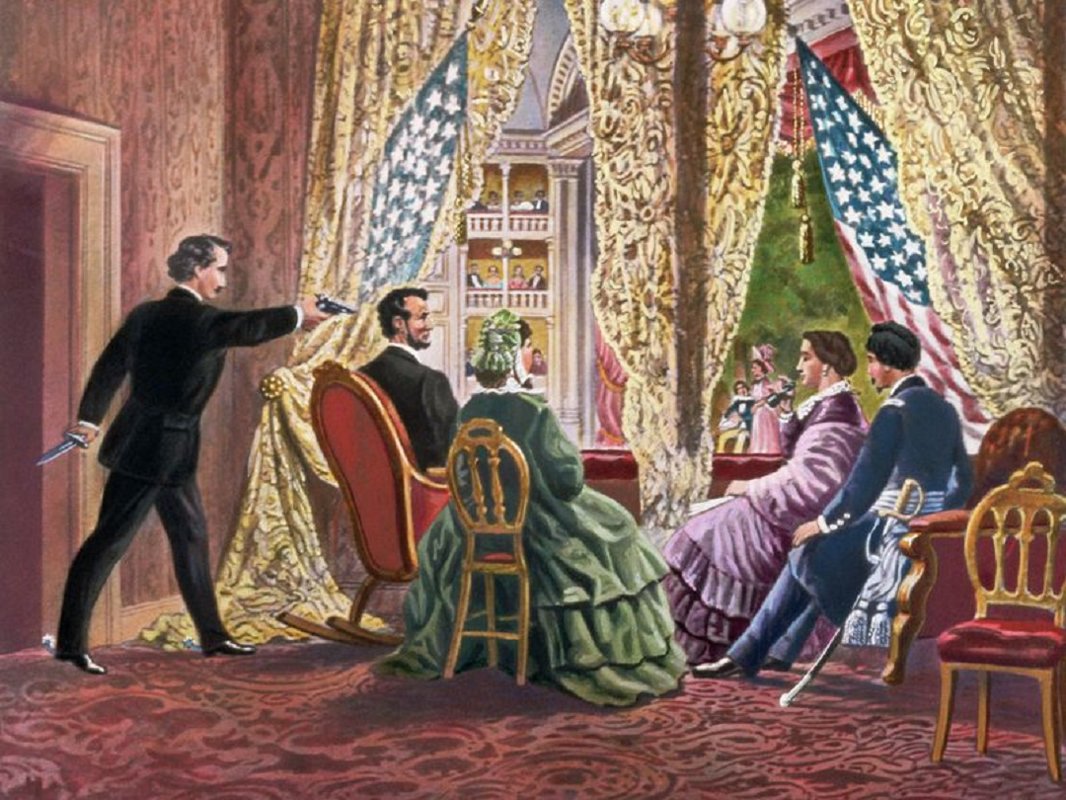 On April 14, 1865, President Abraham Lincoln was assassinated by
a Confederate sympathizer while watching a play at Ford's Theatre
in Washington, D.C. Doctors who attended him recognized he was dying and moved
him across the street to a boarding house owned by William
and Anna Petersen. He was placed in a main-floor bedroom rented by William
T. Clark, a Union soldier who was out for the evening.Lincoln
and his wife Mary see the play "Our American Cousin" at Ford's Theater.
About 10:13 p.m., during the third act of the play, John Wilkes Booth
shoots the President in the head. Doctors attend to the President in the
theater then move him to a house across the street. He never regains
consciousness. April 15, 1865 - President Abraham Lincoln dies at 7:22
in the morning.
On April 14, 1865, President Abraham Lincoln was assassinated by
a Confederate sympathizer while watching a play at Ford's Theatre
in Washington, D.C. Doctors who attended him recognized he was dying and moved
him across the street to a boarding house owned by William
and Anna Petersen. He was placed in a main-floor bedroom rented by William
T. Clark, a Union soldier who was out for the evening.Lincoln
and his wife Mary see the play "Our American Cousin" at Ford's Theater.
About 10:13 p.m., during the third act of the play, John Wilkes Booth
shoots the President in the head. Doctors attend to the President in the
theater then move him to a house across the street. He never regains
consciousness. April 15, 1865 - President Abraham Lincoln dies at 7:22
in the morning.
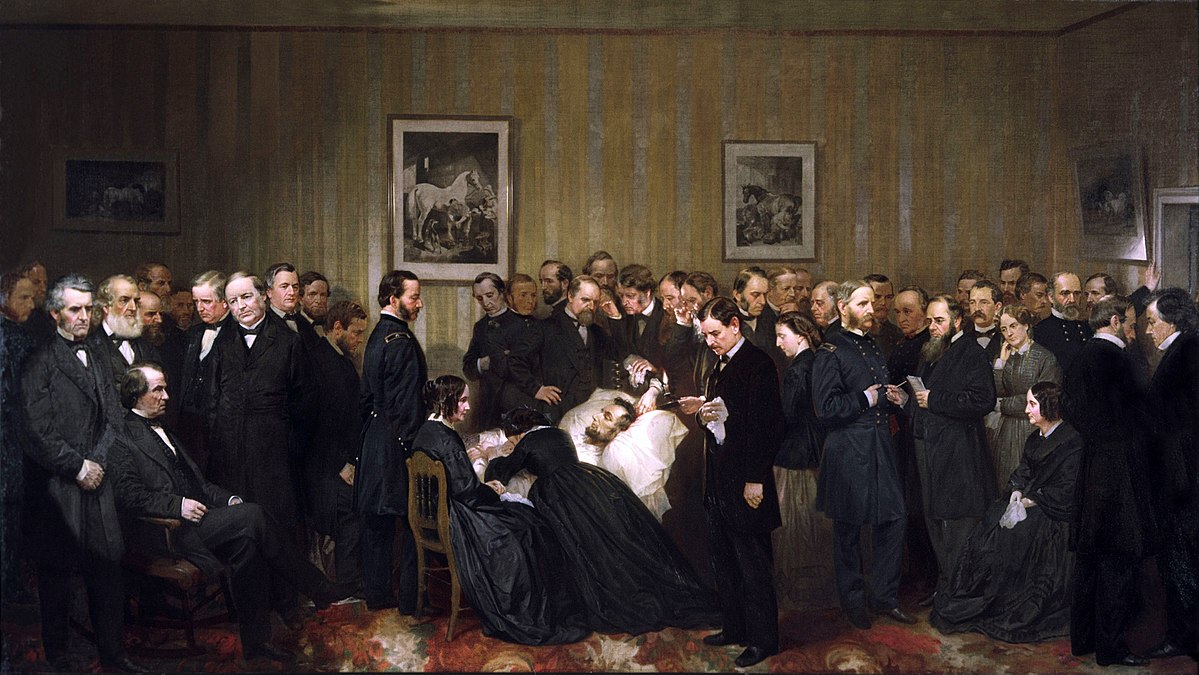 The Last Hours of Abraham Lincoln.Secretary of the Navy Gideon Welles entered the rear bedroom
of the Petersen house soon after Lincoln arrived and noticed that
"the President lay extended on a bed, breathing
heavily." The doctors explained to Welles that Lincoln
could not recover but might linger for several hours.
The Last Hours of Abraham Lincoln.Secretary of the Navy Gideon Welles entered the rear bedroom
of the Petersen house soon after Lincoln arrived and noticed that
"the President lay extended on a bed, breathing
heavily." The doctors explained to Welles that Lincoln
could not recover but might linger for several hours.

